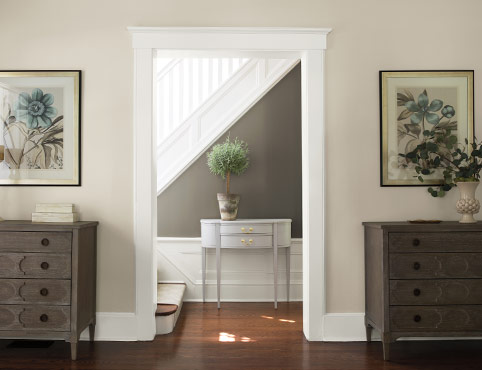Decorating with Art
A Conversation with Wesley MoonLearn about incorporating art into interior designs with Wesley Moon.
Read What Wesley Moon Has to Say:
From his New York City apartment, acclaimed designer Wesley Moon discusses his preferences on displaying artwork, explores how to build a collection, and explains how to incorporate art into interior design.
Displaying His Art Collection
“It's really important, when you're building a collection, to make sure you love every single piece,” says Moon, seated in front of his own personal art collection. If you don’t have the right art for a spot, Wesley recommends waiting until you find a piece you love.
“I do a lot of referencing to historical interiors whenever I design, and I love paneled rooms.” Moon’s preference for paneling is displayed in his stunning living room, where he sectioned off the walls in a way that divides up the space. Working with Studio E Wallpaper, Moon ended up with three different patterns, each in the same colorway, that mixed and matched on the room’s wall panels. This approach allowed him “to get an interesting texture, but still keep it consistent.”
Compared to Moon’s eclectic and colorful selection of art, the patterned paneling in his living room acts as a neutral foundation from behind the cozy sectional seating area.
Sharing Your Personality Through Art
“Artwork is how people truly express themselves in their home,” says Moon, citing his own personal collection as an example.
“Whenever you buy something that you love, it is automatically going to represent you in some way,” says Moon. “I've found that art is actually the most personal thing in a space. It's something that you really have to connect with; people want to feel something when they look at their artwork.”
One of the biggest myths about art, in Moon’s opinion, is that you must hang it on a white wall. “You see it in galleries on white walls. You see it in museums on white walls. But that's not how people live.”
Though the default may be white paint, Moon says taking the entire space into consideration is important when displaying your collection. “The important thing is just to be sure that the art complements, and doesn’t fight with, the wall finish. You have to think about scale. Is there pattern in the wallpaper or pattern on the wall finish?” Moon recommends that the scale of the art should be opposite to the patterns around it.
Another consideration? The vital role of the frame. “Framing is so important,” says Moon. “You have to think about the frame, and how it’s going to divide the piece from the wall finish.”
Ultimately, Moon believes that you should love the art you own. “As long as you love it, it's going to work. If that art represents you, then somehow it's going to work in your home because your home should represent you.”

Sample Our Best-Selling Paint Colors
Order Benjamin Moore paint samples, organized by best-selling hues within each color family.


Inside Design
Explore distinct design topics from the interior designers featured on this page.